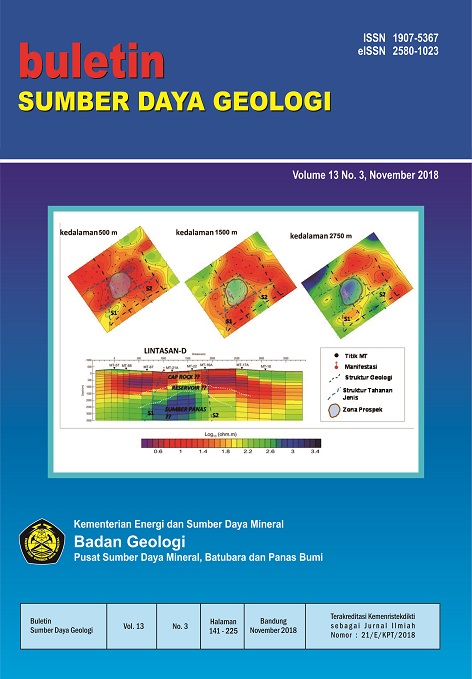IDENTIFIKASI SISTEM PANAS BUMI DAERAH WAPSALIT BERDASARKAN STRUKTUR TAHANAN JENIS DATA MAGNETOTELLURIK
Abstrak
Daerah panas bumi Wapsalit berada di Pulau Buru, Maluku, Indonesia yang secara geologi berada pada lingkungan non-vulkanik. Berdasarkan penyelidikan terdahulu, daerah ini memiliki prospek panas bumi di sekitar area manifestasi panas bumi yang dikontrol oleh perpotongan dua sesar. Proses inversi 2-Dimensi dari data magnetotellurik (MT) dilakukan untuk menggambarkan sebaran tahanan jenis batuan bawah permukaan. Proses inversi ini menggunakan algoritma Active Constraint Balancing (ACB) yang memanfaatkan prinsip spatially variable regularization parameter. Lapisan konduktif yang berfungsi sebagai lapisan penudung berupa batuan metamorf terubah muncul di dekat permukaan hingga kedalaman 1000 – 1250 meter. Lapisan ini semakin meninggi seiring dengan kedalaman yang mengindikasikan zona reservoir. Zona tahanan jenis tinggi (resistif) dengan bentuk kubah muncul pada bagian bawah yang diinterpretasikan sebagai batuan intrusif muda##plugins.generic.usageStats.downloads##
Referensi
Buonasorte, G., Caranova, R., Fiordelisi, A., & Ungarelli, C. (2013). MT as a tool for Geothermal exploration : a case study from Southern Tuscany. European Geothermal Congress. Pisa: EGC.
Chave, A. D., & Jones, A. G. (2012). The Magnetotelluric Method Theory and Practice. Cambridge: Cambridge University Press.
Chave, A. D., & Weidelt, P. (2012). The Theoritical Basis for Electromagnetic Induction. In A. D. Chave, & A. G. Jones, The Magnetotelluric Method (pp. 19-44). Cambridge: Cambridge University Press.
Goldstein, B., Hill, A., Long, A., Budd, A., Holgate, F., & Malavazos, M. (2009). Hot Rock Geothermal Energy Plays in Australia. Thirty-Fourth Workshop on Geothermal Reservoir Engineering. Standford University, California.
Grandis, H. (2009). Pengantar Pemodelan Inversi Geofisika. Jakarta: HAGI.
Hadi, M. N., & Sulaeman, B. (2010). Surface Manifestation in Wapsalit Geothermal Area, Buru Island, Indonesia. Proceeding World Geothermal Congress 2010. Bali.
Kholid, M., Widodo, S., & Rezky, Y. (2015). 2D Inversion of Magnetotelluric Data from Wapsalit Geothermal Field, Indonesia. World Geothermal Congress. Melbourne.
King, R., & Miller , M. (2010). Multiuse "Triple Play" Hot Sedimentary Aquifer (HSA) Potential of Victoria, Australia. World Geothermal Congress . Bali.
Lee, S. K., Kim, H. J., Song, Y., & Lee, C. K. (2009). MT2DInvMatlab--A program in MATLAB and FORTRAN for two-dimensional magnetotelluric inversion. Computer & Geosciences 35, 1722-1734.
Niasari, S. W., Munoz, G., Kholid, M., Suhanto, E., & Ritter , O. (2015). 3D Inversion of Magnetotelluric Data from the Sipoholon Geothermal Field, Sumatera, Indonesia. World Geothermal Congress. Melbourne.
Rezky, Y., & Zarkasyi, A. (2010). Indication of Intrusive Body in Wapsalit Geothermal Area, Buru Island, Indonesia. World Geothermal Congress. Bali.
Uchida, T., Takakura, S., Ueda, T., Adachi, M., Ozeki, H., Kamada, K., et al. (2011). 3D Magnetotelluric Survey at The Yanaizu-Nishiyama Geothermal Field, Northern Japan. Proceedings of the 9th Asian Geothermal Symposium. Ibusuki.
Zarkasyi, A., & Takodama, I. (2016). Survei Magnetotellurik dan Time Domain Elektromagnetik Daerah Panas Bumi Wapsalit, Kabupaten Buru, Provinsi Maluku. Bandung: Pusat Sumber Daya Mineral Batubara dan Panas Bumi.
##submission.copyrightStatement##
##submission.license.cc.by-nc-sa4.footer##Penulis yang naskahnya diterbitkan menyetujui ketentuan sebagai berikut:
Hak publikasi atas semua materi naskah jurnal yang diterbitkan/dipublikasikan dalam situs Buletin Sumber Daya Geologi ini dipegang oleh dewan redaksi dengan sepengetahuan penulis (hak moral tetap milik penulis naskah).
Ketentuan legal formal untuk akses artikel digital jurnal elektronik ini tunduk pada ketentuan lisensi Creative Commons Attribution-ShareAlike (CC BY-SA), yang berarti Buletin Sumber Daya Geologi berhak menyimpan, mengalih media/format-kan, mengelola dalam bentuk pangkalan data (database), merawat, dan mempublikasikan artikel tanpa meminta izin dari Penulis selama tetap mencantumkan nama Penulis sebagai pemilik hak cipta.
Naskah yang diterbitkan/dipublikasikan secara cetak dan elektronik bersifat open access untuk tujuan pendidikan, penelitian, penyelidikan, dan perpustakaan. Selain tujuan tersebut, dewan redaksi tidak bertanggung jawab atas pelanggaran terhadap hukum hak cipta.















